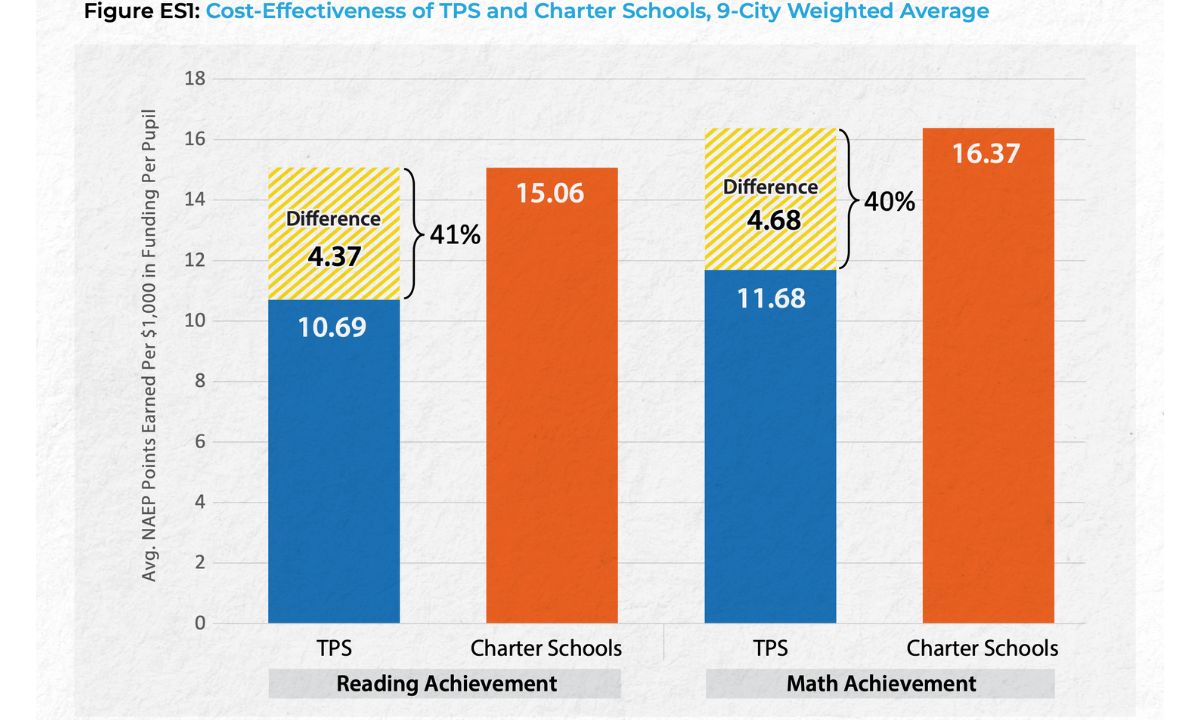Charters Yield More Learning, Higher Earnings than District Schools Per $1 Spent
Wolf: With a 58% higher return on investment over a 13-year education and a fiscal cliff ahead, districts should put their money on what works.

Get stories like this delivered straight to your inbox. Sign up for The 74 Newsletter
Public schools are about to face a heap of fiscal challenges. With billions of dollars of federal COVID relief about to run out, student enrollment dropping and pension obligations skyrocketing, there are tough choices ahead for districts.
But for certain public schools, funding challenges are nothing new. For the last two decades, our research team at the University of Arkansas has been studying charter school funding in major cities across the country. Over the summer, we released a report that found that across 18 cities in 16 states, charter schools receive, on average, 29.5% less funding — $7,147 less per student — than neighboring traditional public schools. This inequity is nothing new.
Our first report, which studied the 2002-03 school year, found a 27% funding gap. Since then, the gap has never been smaller than 20.7%, and it has on a number of occasions been higher than 30%. In other words, students who decide to attend a charter school in one of those cities will, on average, typically sacrifice nearly a third of their funding.
Of course, it’s not just about spending — ultimately, the goal is better outcomes for students. And so, for our newest report, our team combined funding research with data on student achievement so we could see what taxpayers are getting for their money.
The findings were clear: Public charter schools are a great investment. Across nine major cities — Camden, New Jersey; Denver; Houston; Indianapolis; Memphis; New Orleans; New York City; San Antonio, Texas; and Washington, D.C.. — we found that, despite persistent funding gaps, charter schools produced more learning and higher predicted lifetime earnings than traditional public schools per education dollar spent.
As education leaders make tough financial choices in the coming months, properly funding charter schools should be a no-brainer. After all, if they can achieve these results even with a yawning funding gap, imagine what they could do if they were funded equitably.
To obtain our findings, we matched our funding research with performance data from the National Assessment of Education Progress and research findings from the CREDO Institute at Stanford University. Notably, this methodology accounts for observable differences between the student populations of charter schools and traditional public schools, including prior academic achievement — and so it is truly an apples-to-apples comparison.
The results were striking.
In reading, charters average 4.4 NAEP points higher per $1,000 spent than traditional public schools, making charter schools 41% more cost-effective in reading.
In math, charters average 4.7 points higher per $1,000 funded, making them 43% more cost-effective in math.
We also examined how attending a charter school instead of a traditional public school would affect lifetime earnings for students. To estimate this, we used wage data from the Bureau of Labor Statistics alongside the aforementioned CREDO study. And once again, charters came out on top. On average, each dollar invested in a student’s schooling in traditional public schools yields $3.94 in lifetime earnings. That same dollar invested in a charter school student yields $6.25 in lifetime earnings — a 58% higher return on investment over the course of a 13-year education.
What does this mean for education leaders? Despite the political noise, it’s clear that charter schools are a great use of public resources when it comes to what really matters: outcomes for students. As purse strings tighten, leaders should keep that in mind.
Successful businesses follow a simple practice: They direct more resources toward their more productive units. That’s not what is happening in public education these days. If charters were at least funded equitably, it’s easy to see how they could take their performance to another level, providing even better opportunities for their students.
After several years of mostly negative news coming out of public schools, education leaders should take advantage of this opportunity.
Get stories like these delivered straight to your inbox. Sign up for The 74 Newsletter

;)
